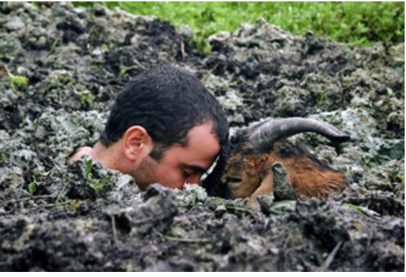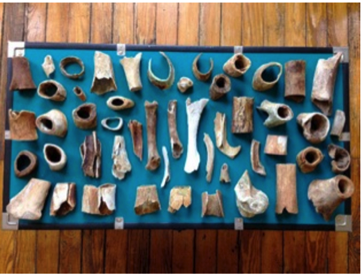Jovana Stokic and Rodrigo Braga in Conversation @ Residency Unlimited in Brooklyn,NYC
Review. October 24th, 2013.
Rodrigo Braga[i] is a Brazilian artist in residence in Brooklyn, New York. Stokic[ii] led the conversation towards a full exploration of the artist’s works. She carefully stitched together his rich diverse twelve-year artistic practice, consisting of solitary performances with nature and animals, which are then, photographed and shared with his audience.
Modernism had a great impact on Brazilian art, and the norm for many decades was the production of anthropophagic-inspired works. Now, contemporary artists in Brazil have assimilated later trends based on city life and all its aspects and has displayed a huge diversity of styles in tune with the growing globalized art tendencies. Braga seems not contaminated by the tiring politics and discourse of contemporary art scenes where works produced are only powerful if they are instigated by those trends.
Braga works are very phenomenal—focused on the existential experience of the being in relation to the surroundings. Reviewing his earlier works during the talk, the artist has retained the authenticity of his Northern Brazilian background. There are so many layers in his early videos, including the direct dialogue with the Brazilian Poetics of Concretism, particularly the acclaimed poet João Cabral de Mello Neto,[iii] also from the North. It is all there— the goat, the spoon (as Cabral’s knife), the backland, the swamp, the crab, the unconquerable stone.
The artist takes a step forward: After intentionally setting the arena to dwell the conditions of all possibilities of interactions through the struggles between the body and nature, and the body and animals, these actions become fully realized. Consequently, Braga proposes a new world beyond its known boundaries. “Radical change in our lives occurs when the methods of our time-worn practices, checked and rechecked, are unable to account for a growing accumulation of instances and questions to the contrary, and we are forced to go deeper (to expose the hidden orthodoxies)”, says Robert Irwin in his 1985 Essay Being and Circumstance [iv]. Braga frees himself to become the imaginary animal and the “things” he will encounter in his explorations.
The research and the artworks produced during his residency at RU[v] were accomplished during the short period of forty-five days. Braga rediscovers and claims a place-in-between in Brooklyn, New York City, the dystopic Dead Horse Bay—a small beach off Barren Island between the Gerritsen Inlet and Rockaway. During the late nineteenth century and mid twentieth century the place hosted the remains of dead animals, especially horses, and more recently it has become the landfill for the disposal of New York City’s garbage. Braga’s new interdisciplinary work resonates the aesthetic of Joseph Beuys. At the site, he is an archaeologist, unveiling whatever is brought up to the shore by the increase of water level and the devastating changes of the environment over decades.
Braga reclaims new possibilities for the found objects. Once transported into the residency gallery space, the collected bones are filled with fat resting on driftwood shelves. Tails of horses are now dipped into broken water bowls.
In his newest video composing the installation, his performative self is the horse itself, galloping along the renegade beach, lending us its right eye to sense the space and experience the solitary sanctuary of dead animals within NYC. Beuys says in his essay What is Art? that in the principle of motion, “something is conveyed from here to there, and the only thing that counts is how far you take it from one pole to the other. Movement accords completely with the human being, he concludes, “The most important creative factors, the three most important structures are: Thinking, feeling and movement and power of will.”
In Braga’s works, all is set in motion by his strong will to bring the place from the cracks of forgetfulness. Through the camera-ghost of his horse and its embodied wild motions, he is no longer the ontological being. He is liberated from old cultural references. He allows us, his audience, to become sensorial and to re-think with our own logic and our own bodies, the significance of lost objects.
[i] http://www.rodrigobraga.com.br/
[ii] Jovana Stokic is a Belgrade-born, New York-based art historian, critic and curator. She holds a PhD from the Institute of Fine Arts at the New York University. Her dissertation, titled “The Body Beautiful: Feminine Self-Representations 1970 – 2007,” analyzes works of several women artists – Marina Abramovic, Martha Rosler, Joan Jonas — since the 1970s, particularly focusing on the notions of self-representation and beauty. Jovana has been writing art criticism for several years, and has curated several thematic exhibitions and performance events in the US, Italy, Spain and Serbia. Jovana was a fellow at the New Museum of Contemporary Art, New York, a researcher at the Whitney Museum of American Art, New York, and the curator of the Kimmel Center Galleries, New York University. She has most recently written an essay for Marina Abramovic’s MoMA exhibition catalogue.
[iii] João Cabral de Melo Neto (1920 – 1999) was a Brazilian poet and diplomat. He is considered one of the greatest Brazilian poets of all time. Neto was awarded the 1990 Camões Prize, the most important prize in Portuguese language and the 1992 Neustadt International Prize for Literature. Education by Stone is one of his most celebrated books. In his poetry, Neto opts for the hard objective reality, hiding any open and sentimental visions of it. The realities that informed his building materials were the arid lands of his native northeastern Brazil and other countries—especially Spain—where he served as a career diplomat. The poet constructed his poems as an architect. Some of his poems are socially engaged, and he remained emotionally removed, without giving subjective reflection or obvious compassion. The images and the verses that emerge from the verses are reduced to their basic structural lines and constructed into a self-functioning poem-machine.
[iv] Irwin, Robert. “Being and Circumstance,” Essay from Notes Toward a Conditional Art. California: Lapis Press, 1985
[v] http://www.residencyunlimited.org/residents/2013/09/rodrigo-braga/


Rodrigo Braga| Earth| Photography| 2008
Dead Horse Bay| Rescued Objects |2013